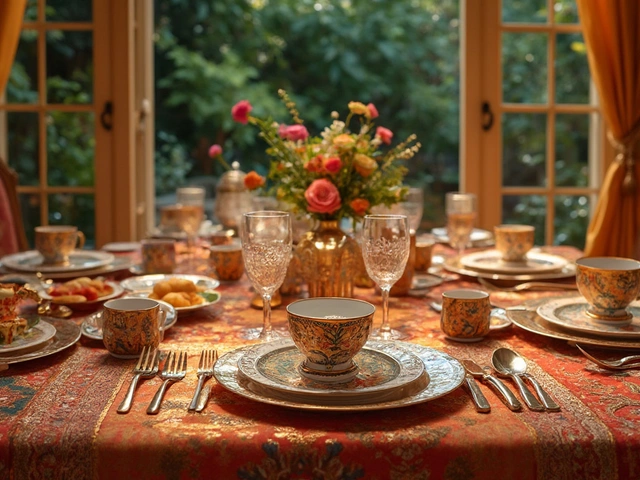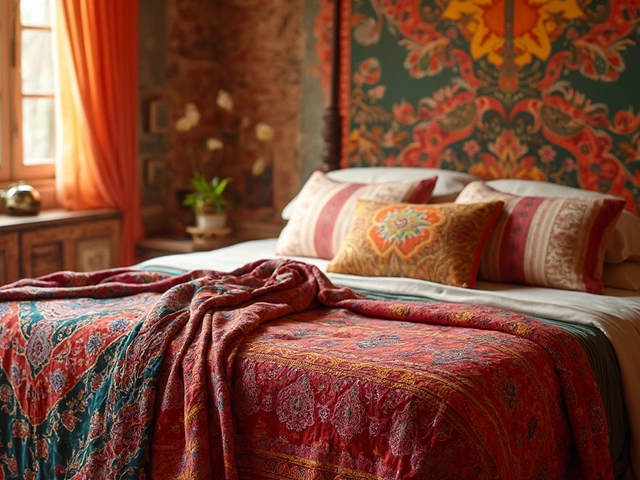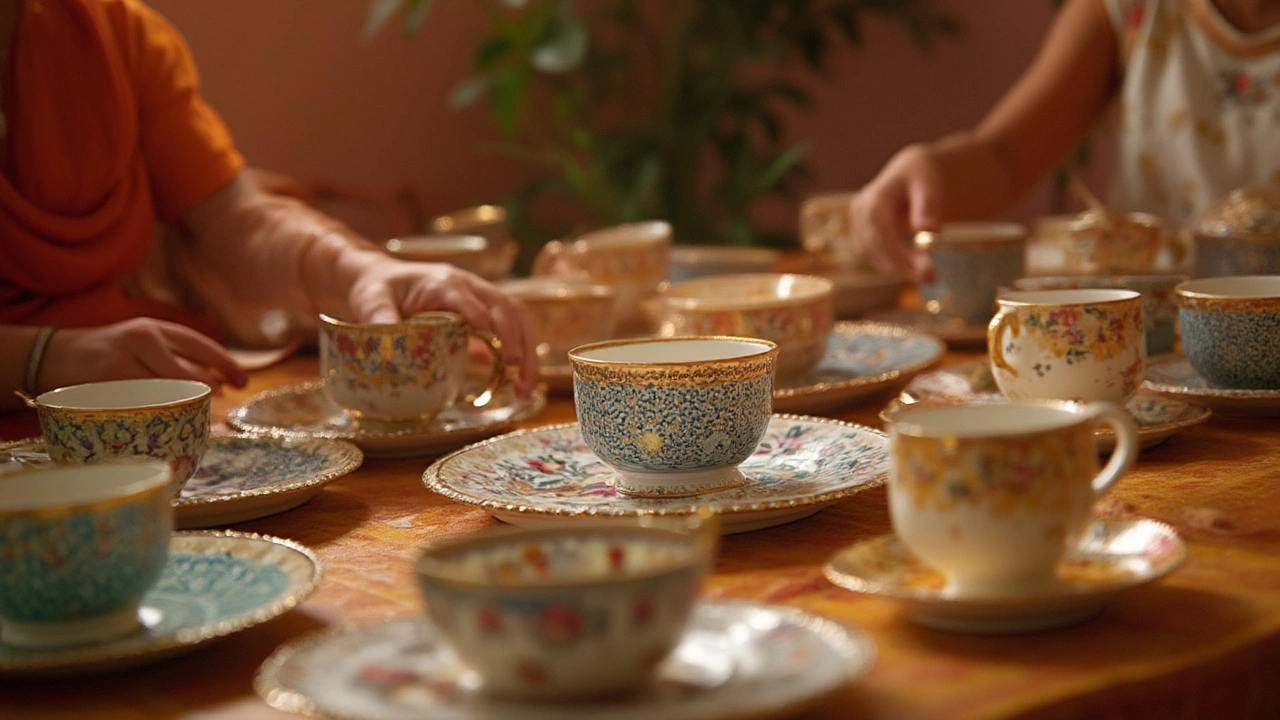
Ever frantically looked through a cabinet and realized you had no idea what to call all the matching cups, saucers, and plates spilling out? If you’ve ever hosted a holiday meal — my kids, Orla and Tegan, constantly asking if the “fancy plates” come out — you know these pieces matter. But outside the dinner party panic, what’s the proper name for this collection? You’d be surprised how many people use the wrong term, and the right answer can change depending on where you live, what you’re serving, and even how posh you want to sound at the table. Spoiler: “Cups, saucers, and plates” isn’t exactly what you’ll find on a store sign. Let’s dig into the world of tableware, its impressive history, and how to keep your kitchen talk on point.
Defining the Essentials: What Do You Really Call This Set?
If you walk into a store and ask for cups, saucers, and plates as a single group, most salespeople will nod and say, "Oh, you mean tableware." This umbrella term covers nearly everything you use when eating or serving food, from mugs to dinner plates. But it gets more interesting the deeper you go. Tableware splits into three big camps: dinnerware, flatware, and drinkware. Dinnerware (sometimes called "chinaware," if it’s fancier or made from china) usually includes plates of all sizes, bowls, saucers, and cups. Flatware is your knives, forks, and spoons. Drinkware is for mugs, glasses, goblets, and the like.
The words change on you fast. In the U.S. and Canada, "dinnerware" is super common. In the U.K., the word "crockery" often pops up instead, especially in homes that love Sunday roasts and big tea sets. Aussies might call it "china" (even if made of stoneware or porcelain — funny how that works). If you haul out that special wedding set that only appears twice a year, many will simply say "the good service." Feeling lost? Check this quick reference table:
| Region | Common Term | Example Items |
|---|---|---|
| US/Canada | Dinnerware | Plates, saucers, cups, bowls |
| UK | Crockery | Tea cups, side plates, serving platters |
| Australia/NZ | China | Dessert plates, espresso cups |
Why does this even matter? Because knowing the right term saves you time, embarrassment, and makes online shopping a thousand times easier. If you want to impress someone with good taste, call your full matching set your "tableware." If it’s just plates and matching bowls, call it your "dinnerware."
Tableware, Dinnerware, and Crockery: What’s the Difference?
If you really want to sound like you know your stuff—or just settle a debate at dinner—understanding the differences between these words is a game changer. Tableware is the family name. It includes everything that goes on the table, except things like pots or serving pans. It covers dinnerware and drinkware. So, if you have coffee mugs and juice glasses? Still tableware. If you’ve got a collection of commemorative plates from family holidays? That’s dinnerware, all day.
Here’s a fun fact: The word "dinnerware" appeared in English only as early as the 1900s, likely to market those matching sets that became popular with department stores. Before that, most homes mixed and matched whatever pottery or porcelain they had—sometimes from three or four generations of the same family. That’s where “crockery” came in, describing all ceramic household dishes. If your granny ever said, “Take out the good crockery,” she was just telling you not to eat on the chipped stuff.
What about "servingware"? Throw this term out when you’re talking about platters and serving bowls. But don’t include regular plates or mugs under this word. Confused yet? Check out this short list to clear things up:
- Tableware: Everything you eat from or with—cups, plates, bowls, glasses, cutlery
- Dinnerware: Plates, bowls, cups, saucers (stuff you eat off)
- Drinkware: Mugs, tea cups, wine glasses, tumblers
- Flatware: Forks, spoons, knives (stuff you eat with)
- Crockery: Ceramic dishes, especially in the UK/Commonwealth
Having a go-to word for your collection isn’t just about sounding smarter. It makes cleaning, organizing, and buying more efficient. Ever try to buy a replacement saucer and stared blankly at thirty options? Use precise words and you’ll always land the right piece.
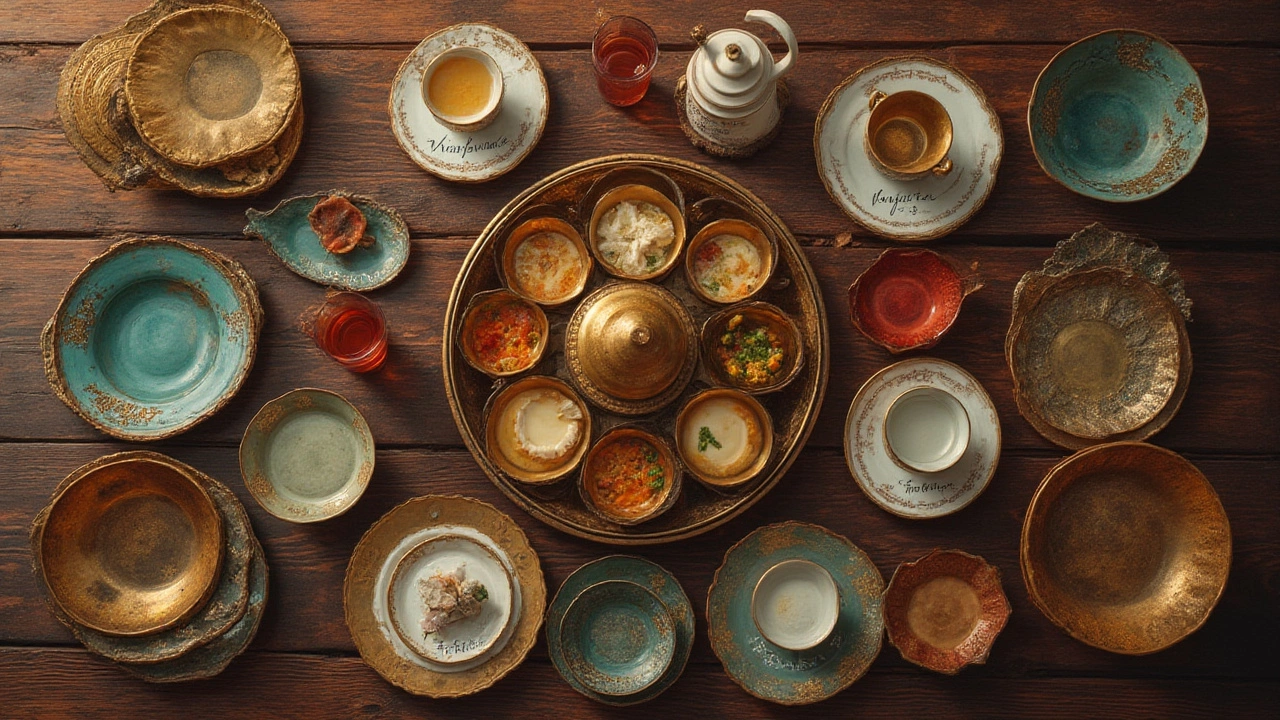
How Culture Influences What You Call Your Dishes
So much about what we call our plates and cups comes from where and how we’ve lived. In France or much of Southern Europe, “faience” might pop up as a synonym for fancy ceramics. In India, “thali” is a specific plate, but families refer to "utensils" for the whole stack of plates, cups, and bowls brought out at big gatherings. In Japan, “shokki” (tableware) splits again into all sorts of specialist names, like “yunomi” (tea cups) and “sara” (plates). Ever visit a friend of a different background and notice they lay out tiny cups or bowls you never use at home? That’s the cultural twist in tableware naming conventions—words shaped by traditions, meal style, and even superstitions.
Your family might have their unique language, too. In our house, Orla and Tegan love organizing “tea parties.” They crash through the kitchen cabinets, pulling out “tiny plates” (side plates), “fancy cups” (porcelain tea cups), and something they call “sipping saucers”—not a real term, but one that somehow stuck. When everyone brings food to a big holiday meal, you’ll probably hear a dozen different words for the same plate or bowl, and each comes with its own story.
Marketers make things more complicated. Stores change the name depending on what they believe will make someone buy more. Ever seen “Stoneware Essentials” one aisle over from “Contemporary Dinnerware Suites”? Same stuff, different day. The fancy restaurant might boast “fine porcelain table service,” but at grandma’s house, it’s “the Sunday china.” The tableware industry alone was valued at over $40 billion worldwide in 2023, all because people wanted their plates, cups, and saucers just so.
So, sometimes it’s the setting or intention that gives your tableware its name. A picnic? Grab the “picnicware” (even if it’s just plastic plates and cups). Wedding? Find yourself shopping for “formal dinnerware sets.” Monday cereal with kids? “Bowls and mugs” do the trick just fine.
Types and Materials: More Than Just Plates and Cups
Your average home has more variety in tableware than you might realize. Take a peek in your own cabinets—you probably have everyday plates (stoneware or cheap porcelain), “holiday only” dinnerware, mismatched mugs, stackable bowls, and maybe “heirloom” pieces nobody’s allowed to touch (at least, that’s the rule for Orla and Tegan unless it’s a truly special occasion). Modern tableware comes in all kinds of materials: porcelain, stoneware, bone china, glass, metal, bamboo, even fancy plastic that claims to be microwave and dishwasher safe. Here’s something to chew on—bone china is made with real animal bone ash (mostly cow), which is what gives it its see-through look and strength.
Each type and material brings its quirks. Porcelain is durable and dishwasher-safe, but knock it on a granite countertop and you’ll hear the heartbreak from three rooms away. Melamine plastic? Good if you have kids, but don’t microwave it unless you want funky smells or melting drama. Vintage stoneware can seem indestructible, but if you’re storing acidic foods, watch for slow leaching. Even new glassware, though pretty, can shatter under quick temperature shifts—always let glasses tumble to room temp before daring hot liquids. Handy table for quick tips:
| Material | Best For | Care Tips |
|---|---|---|
| Porcelain | Formal dining, everyday plates | Dishwasher safe; avoid rough stacking |
| Stoneware | Casual meals, family use | Check for dishwasher/microwave icons |
| Glass | Dessert bowls, drinkware | Watch for thermal shock |
| Melamine | Kid’s sets, picnics | Hand wash for longer life, avoid microwaving |
| Bone China | Fine tea sets | Avoid sudden impact; hand wash gold trim |
Choosing tableware isn’t all about what looks pretty. Think about the heat of your dishwasher, space in your cabinets, and how many are in your family. For big gatherings, stackable, sturdy plates save time. And never underestimate the power of a mug that fits your hand perfectly—it becomes your favorite.
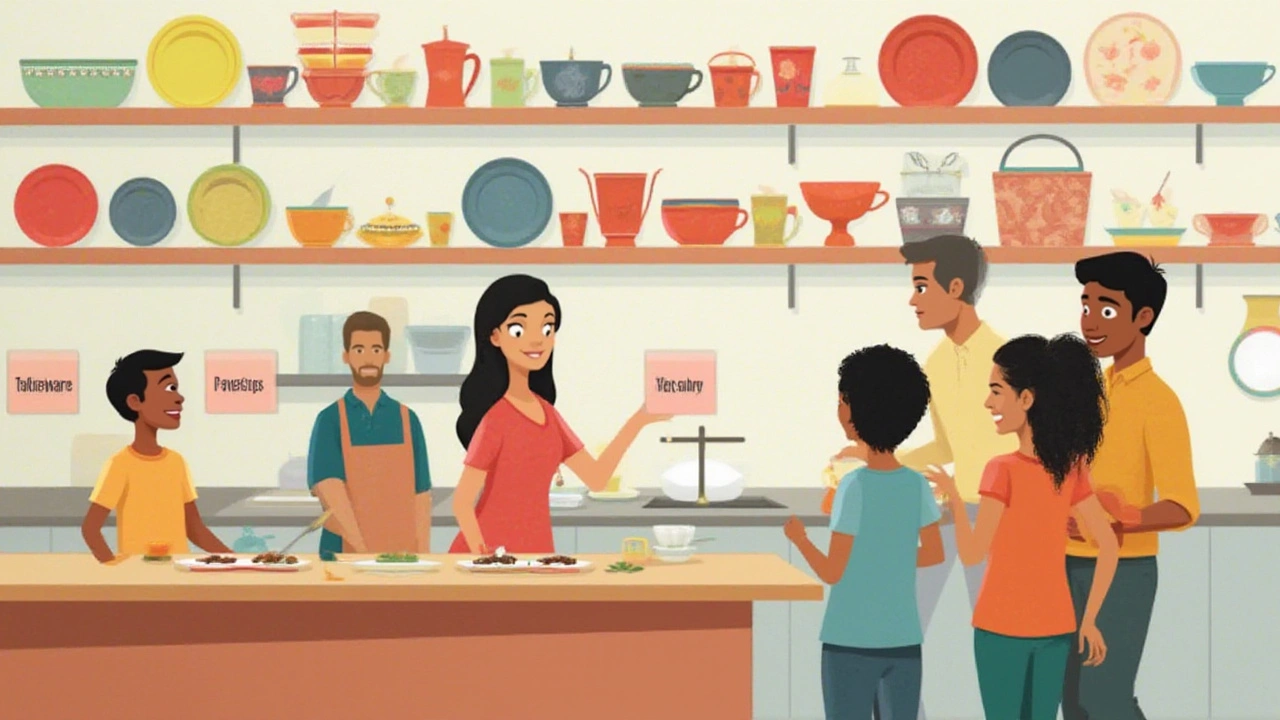
Picking the Right Word: What Should You Say (and When)?
If you want to sound informed when talking about cups, saucers, and plates, match your word to the occasion. “Tableware” is always safe in a store or online search, especially when you mean plates, cups, saucers, bowls, and maybe even pitchers, but not glassware or utensils. "Dinnerware" works great if you’re setting the table for a meal and only mean the pieces everyone eats off. For anything super specific—like fancy tea cups and saucers—don’t be shy and just use those names. Few things get more confusing than looking for a “saucer” and grabbing a “side plate” by mistake.
Here’s a down-to-earth tip: Write labels or shelf markers at home using the industry terms. Not only will it help guests grab the right pieces, but it’ll make you look like you have this kitchen thing all together. When my kids started helping put dishes away, I stuck little photos and labels (“small saucers,” “big plates,” “everyday mugs”)—and suddenly, the post-dinner cleanup chaos halved.
- If shopping for a gift, look for "dinnerware set" or "tableware set." The seller will know what you mean.
- At restaurants, the list isn’t about plates—it’s all “china” or “service.”
- Chatting with friends who love design? “Ceramic tableware” sounds stylish and covers handmade pottery, too.
And in those moments with family or friends, don’t sweat having the “correct” term. Even if you mix up plates and saucers, the best conversations usually happen around a crowded table lined with whatever dishes make food and company feel special.
